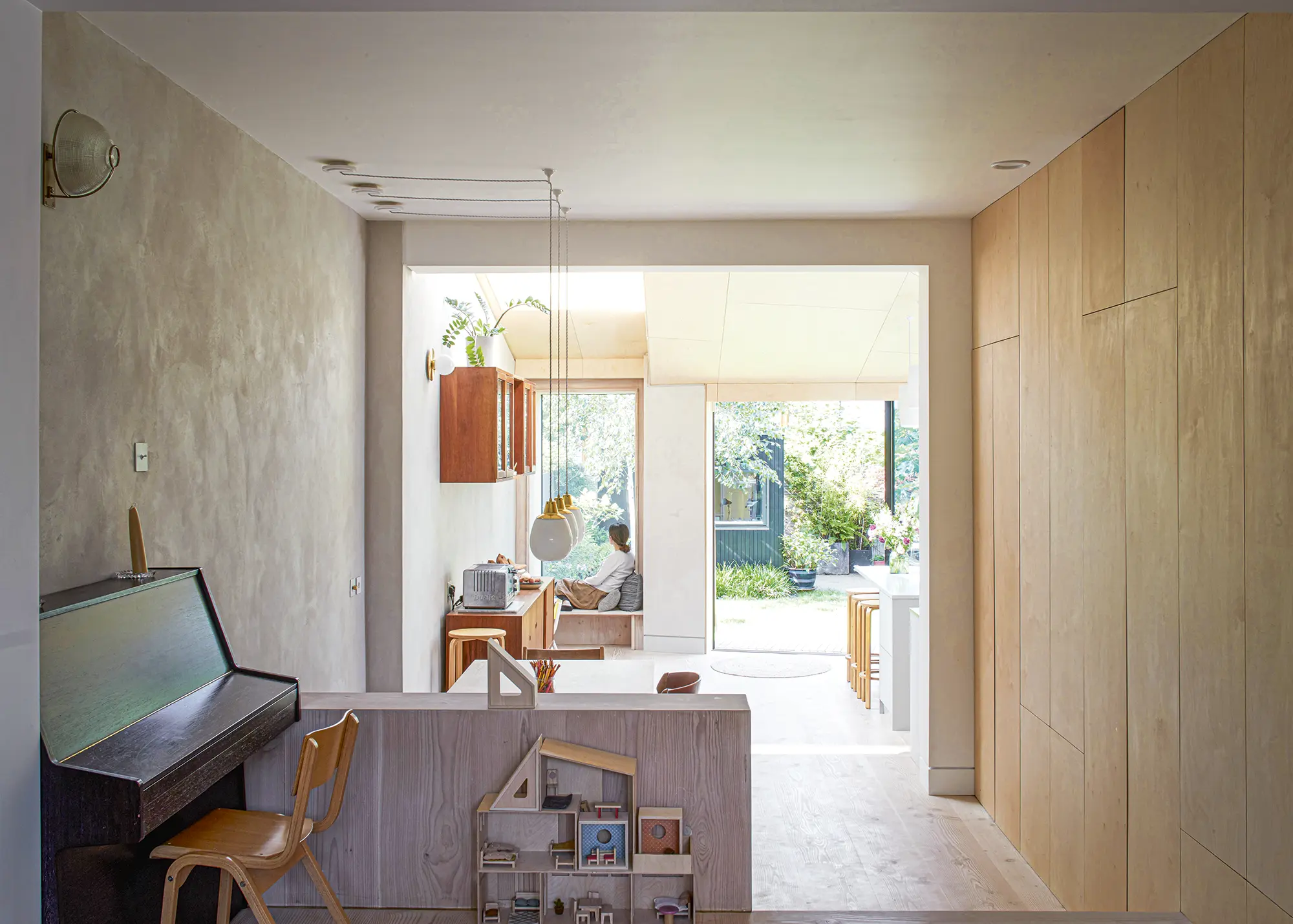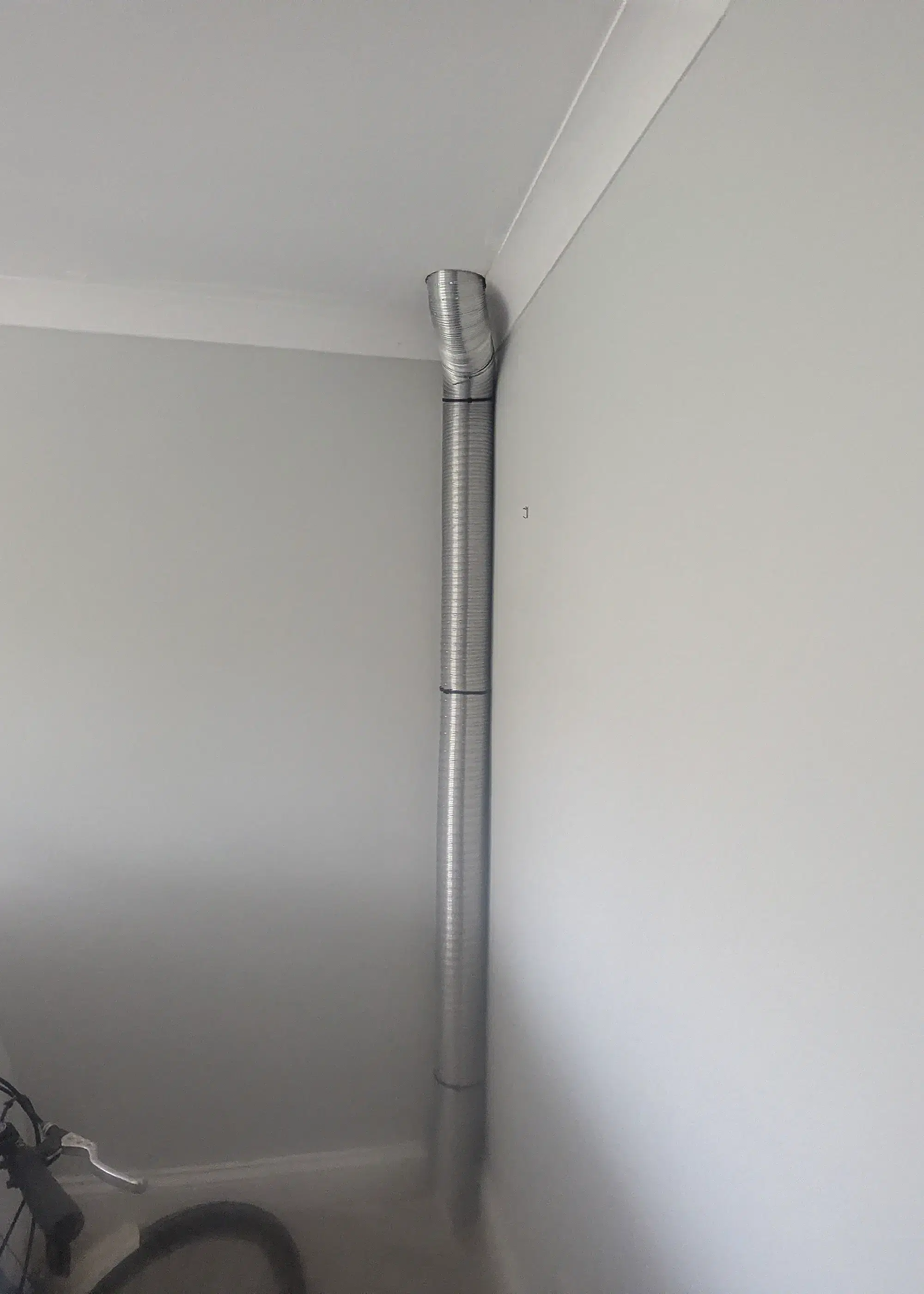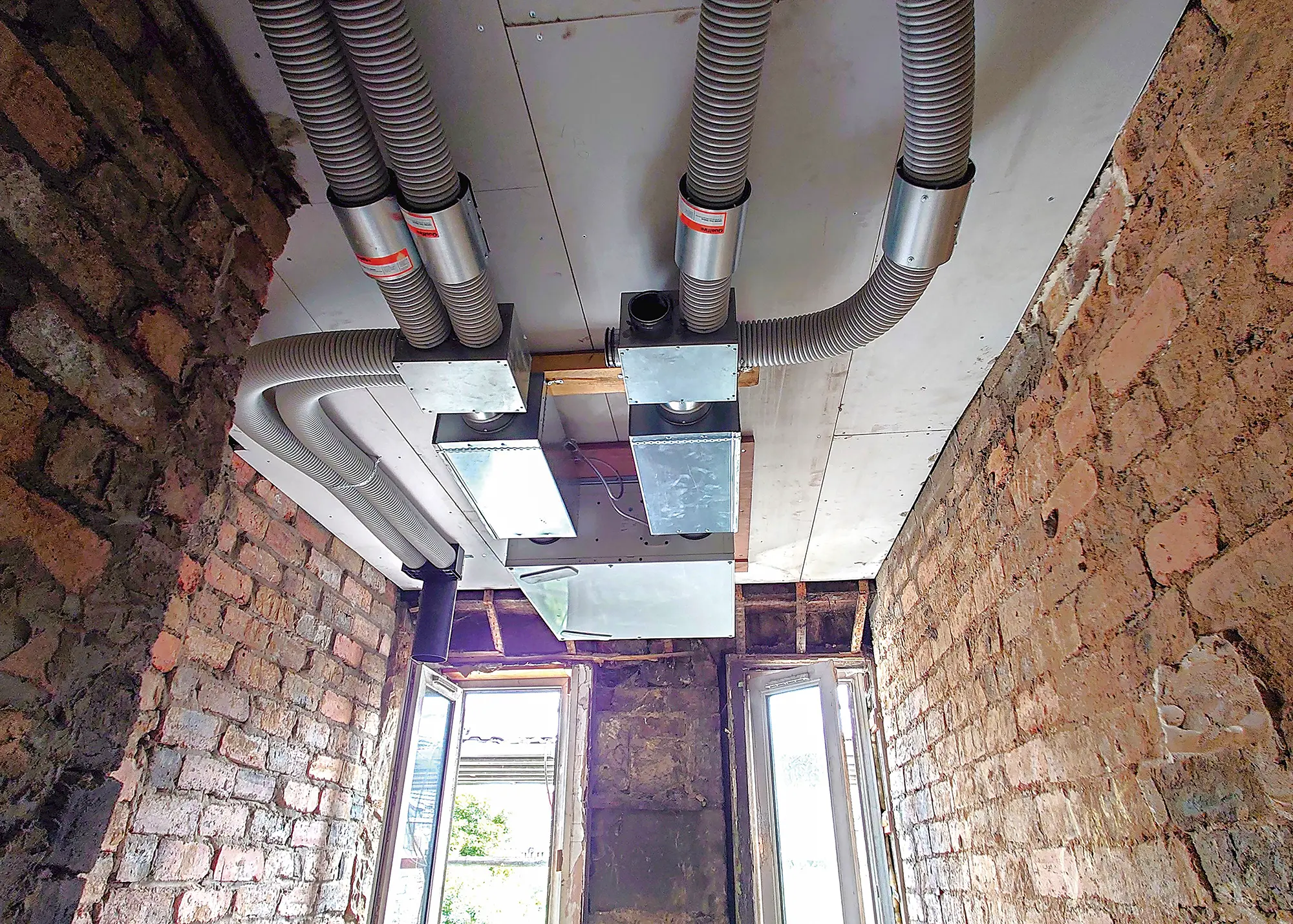
Get your project off the ground with our next virtual training workshop - October 28th at 7pm!
Use code BUILD for 20% off
Get your project off the ground with our next virtual training workshop - October 28th at 7pm!
Use code BUILD for 20% offGood ventilation is a critical factor for creating a healthy internal living environment, as poor air quality can lead to numerous issues including condensation, damp and the accumulation of unpleasant smells, allergens and contaminants.
The removal of stale air and its replacement with a fresh supply can be achieved by various means. One option is to install a mechanical ventilation and heat recovery (MVHR) system, which recaptures outgoing heat from your home to offer savings on energy bills, while also offering improved indoor air quality. So, there’s good reason to consider including MVHR as part of wider renovation works to improve your property’s thermal efficiency. Here, we’re taking a look at the ins and outs of retrofitting MVHR.
First, let’s break down how MVHR works. A mechanical ventilation with heat recovery system removes stale air from your home and introduces a fresh supply. Simultaneously, it extracts and recycles heat from the outgoing stream and transfers the warmth to the incoming flow, potentially reducing your reliance on boilers, heat pumps etc to deliver heat through underfloor heating (UFH) or radiators.
To get the best out of MVHR, it should be installed in a well-insulated, airtight home where warmth isn’t going to leak out via the building fabric. Many existing houses won’t meet those criteria – so, you’ll almost certainly need to make upgrades to thermal performance as part of your project.

Rise Design Studio crafted the design of the renovation and extension of this house in North London. As part of the project, the thermal envelope of the house was upgraded to establish a well-insulated, airtight shell. MVHR provides fresh filtered air throughout the property, while also retaining the heat that has already been used to warm the interiors. Photo: Edmund Sumner |
Usually installed in a plant room, basement or loft, the air-handling unit forms the central hub of the system. It is linked to a series of ducts that are attached to extraction and supply points throughout the house. Stale air is drawn out of each room at the extraction point, channelled to the main unit’s heat exchanger and expelled outside. The extracted warmth is transferred into fresh air, which is then ducted to individual rooms. Filters within the main unit work to remove pollutants from the supply.
As ducting runs are typically installed within the fabric of the building, finding space for them in a retrofit scenario can be challenging – but it’s by no means impossible. Here, we debunk the myth that you can’t install MVHR in an existing home, as well as exploring the solutions for making your installation easier.
If you’re renovating a house and improving its property’s thermal performance, you can increase the risk of locking in moisture, leading to condensation and mould growth. “When upgrading insulation or replacing windows, ventilation to the property can take a big hit,” says Robert Hamilton, managing director at Rega Vent. “Fitting MVHR will help provide ventilation, assisting in the reduction of mould and providing the benefits of heat recovery, helping to reduce heating costs.”
For most existing properties, trickle vents, airbricks and natural solutions (opening windows and relying on leaky building fabrics) take the load when it comes to removing stale air and bringing in a fresh supply. If the kitchens or bathrooms have been updated in recent memory, they’ll probably have extractor fans, too.
“However, even if trickle vents are kept open – and homeowners often shut them because they let cold air in during winter – they won’t work well when there isn’t a suitable difference in air temperature/pressure between inside and out, as there won’t be any air movement,” says Clarissa Youden, associate director at Total Home Environment. “Even with extractor fans pulling air from the wet rooms, they aren’t on for long enough to provide adequate ventilation for the whole house.”

Ventilation terminals can be wall mounted, as high as possible, if you can’t route duct to a ceiling of a room. Total Home Environment provided the MVHR system for this retrofit project
Positive input ventilation (PIV) systems are often considered to be the go-to solution for renovation scenarios because they’re straightforward to install. A fan-powered unit is installed, usually in the loft, which draws in fresh air from outside. The incoming flow is propelled through the house via a network of ducts.
As the fresh air is drawn in, the pressure increases, and stale air is pushed out through gaps in the fabric of the building – so it’s well-suited to less efficient homes. If you’re making substantial upgrades to the thermal envelope, though, PIV may not be a good fit.
What a PIV system can’t do is provide dedicated control over air quality. “PIV doesn’t create a specific ventilation path. For example, an occupied bedroom with the door closed might benefit next to nothing from PIV,” says Stefan Huber, managing director at Paul Heat Recovery. “Another drawback is that cold air is pumped into your home in the colder seasons, while in summer, scorching hot air is all a PIV system can introduce. MVHR systems, on the other hand, can really control internal air quality.”
CASE STUDY Retrofitting MVHR in an Oxfordshire bungalowTotal Home Environment took the lead in planning the design and installation of the MVHR system in this detached Cotswold stone bungalow. Keen to modernise the property – particularly the kitchens and the bathrooms – the owners decided to install MVHR to prevent mould and mildew growth that was caused by inadequate ventilation. Prior to their project, high humidity levels had resulted in mould growth on the walls, condensation pooling on window cills and black marks appearing on the wallpaper. The humidity levels also made the property difficult to sleep in on warm summer nights. Total Home Environment supplied and fitted a Genvex heat recovery system to combat these issues. As the property is set over a single storey, installation was a fairly simple process. “All the work was done in the loft,” says Clarissa Youden, associate director at Total Home Environment. “It was a cold roof space, meaning all the metal ductwork – apart from the exhaust duct – had to be insulated.” The air-handling unit was installed above the bathroom in the loft, away from the bedroom to minimise sound. The installation took just two days for a three-person team to complete. |
Many people think it’s not possible to retrofit MVHR unless you completely gut a property. “Fitting the ductwork into an existing home can be difficult due to the size of the pipes, but there are a range of different options available,” says Robert. Where space is at a premium, ducting can be hidden in bulkheads or false ceiling voids, for instance. Rigid spiral wound steel ducting generally performs best – and can be left exposed if you want to introduce an industrial aesthetic to your home’s interiors. However, in retrofit projects where space is tight, semi-rigid solutions that offer more flexibility can make it easier to fit the system.
The ideal location for an MVHR unit would be in a utility or plant room close to an external wall. However, in retrofit scenarios sometimes the only space for the air-handling unit is in the loft. “The good thing about the unit being in the attic is that you can hide a lot of the ducting up there, certainly the ducts going to upstairs terminals,” says Clarissa. Installation therefore tends to be fairly simple in bungalows, as the unit and all the pipes can be hidden in the attic, providing you have good access to the space for maintenance.

In this installation by Rega Vent, exposed MVHR ducting brings an industrial flourish to the decor of the property
Ducting can be laid beneath the loft insulation, with external terminals ideally installed in the property’s gable end wall. “For two-storey homes, you then just need to T-off and find drops to get down into the floors below – at the back of a fitted wardrobe, airing cupboard, behind the bath or by adding some extra boxing-in next to existing boxing are all good options,” says Clarissa.
If installing the runs of ductwork is tricky in a two-storey property, an alternative strategy could be to use a hybrid approach, such as MVHR on the upper storey and natural solutions on the ground floor. Another option is a cascade ventilation system, where the MVHR design focuses primarily on ducting to the bathroom and/or kitchen. “This often works alongside cascade fans that distribute fresh air to the habitable rooms without ducting,” says Stefan. “It can be easier to install in certain buildings, but requires a sizeable hole through an external wall.”
Where structural issues are prohibitive to installing a whole-house system, decentralised MVHR could be employed (possibly in conjunction with a centralised unit for part of the house).
If you’re interested in dMVHR, sometimes known as single-room heat recovery, be sure to look for high-quality products that offer proven efficiency and low noise output.
There are various types of dMVHR, but the most prevalent single-room solutions operate on a push-pull basis – essentially breathing air in and out as they switch between extraction and supply at regular intervals.
“They change air flow direction every minute or two and recover some heat through a thermal storage element,” says Stefan. “They’re normally used in tandem with two or more other systems. Brilliant in theory, though they’re limited in terms of providing good air quality.”
Whether in the form of extra insulation in your floors, walls and roof, or the installation of new windows, if thermal upgrades to your property result in air tightness levels of 5m3/h.m² @50Pa or better, then you will need to consider mechanical ventilation. At this level of airtightness, trickle vents alone will not provide adequate ventilation.

This MVHR setup was supplied and installed by the team at Paul Heat Recovery as part of a full house renovation project
MVHR offers an appealing ventilation solution owner that can also improve air quality and make your heating system more efficient, plus there are a number of options to retrofit it into an existing property.
If you’re installing a whole house system there will, of course, be some disruption. “However, the health benefits for you and your home, as well as the reduction in heating costs, should make this worthwhile in the long run,” says Clarissa.
Great article explaining some of the considerations around retrofit MVHR. I did just want to put in my penny’s worth, and that is that MVHR is not always disruptive, at least, it doesn’t have to be.
What is missing from this article is a clarification that this is all based around the conventional centralised (i.e. ducted) MVHR where there is a central air handling unit, and then you have ducts supplying fresh air to the habitable rooms and ducts extracting from the wet rooms.
There are alternative methods available, known by a number of terms such as single-room MVHR (srMVHR), alternate-flow MVHR (arMVHR), or decentralised MVHR (dMVHR). These are ductless systems, and essentially are a through-wall system. This makes then far less intrusive than traditional systems.
Hi Bradley – there is a short section on dMVHR in this feature, but it could be fleshed out more. I’ve added a sub-head to this so it’s more obvious. We’ll look to develop it a little more in the near future. Thanks!
Chris Batesmith (Content Director, Build It)